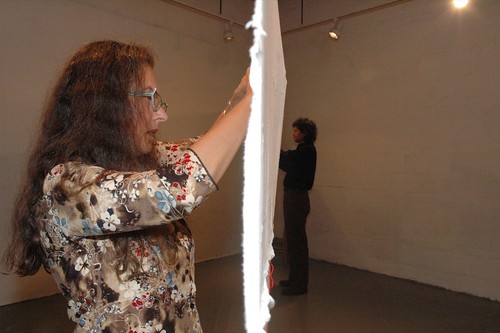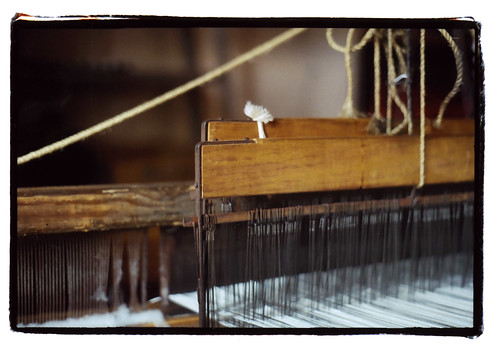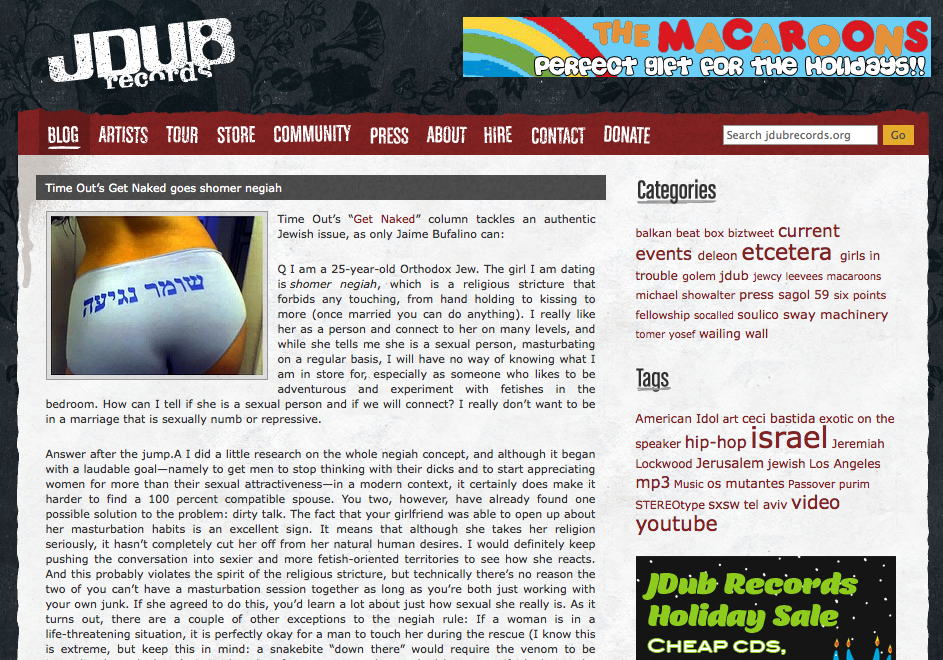Talented Female Artists: Eleanor Dubinsky

Eleanor Dubinsky is a musician, choreographer, video and visual artist whose performances and installations create the experience of travel and a sense of immersion in the unknown. Eleanor's work embraces and inspires imagination and explores our connections to our bodies and to one another. She is interested in expanding who gets to participate in art-making and wants to engage audience members in a sense of wonder, questioning and creativity about their everyday lives. To this end, she rehearses, installs and performs her pieces in public spaces such as train and subway stations, parks and storefront windows. Eleanor’s artistic roots are in music, beginning with classical cello at the age of three. Based in New York since 1999, she has performed and created in France, Poland, the Czech Republic, Argentina and throughout the United States.
be sure check out her myspace page to hear her awesome music...[youtube=http://uk.youtube.com/watch?v=yycdvyycBx4]
Get on the Guagua
coming soon....Eleanor's pieces Fast Body (2007) and Get on the Guagua: a film about getting on the bus and around in general in Havana, Cuba (2006) were selected for the Danca em Foco International Videodance Showing in 2008, which will take place from August 7-24th at Oi Futuro, Rua Dois de Dezembro, 63/4º andar – Flamengo – Rio de Janeiro, Brazil. www.dancaemfoco.com.brEleanor will be in Turkey from July 12-29 participating in a week-long intensive workshop in music and dance improvisation with master teachers Julyen Hamilton and Barre Phillips, followed by a week-long performance residency in Cappadocia with the Paris-based dance and music collective Emma Jupe, of which she is a member. They will be developing and performing new work and performing daily for the local residents in public spaces.
video reel
[youtube=http://www.youtube.com/watch?v=3li_mT--f-A&hl=en]
Joanna Angel: Jews & Tattoos
[youtube=http://www.youtube.com/watch?v=f9laK9l_lq0&hl=en]
- Adult film superstar Joanna Angel pokes holes at the myth that Jewish faith won't allow you to go to heaven if you have tattoos -- and Joanna's got quite a few -- during the Wild Ass Circus' trip to Las Vegas for the 2008 AVN Awards
Guest Post by Debbie Wolen: Ta'anit Esther and Mardge Cohen
Guest Post by Debbie Wolen*: Ta'anit Esther and Mardge CohenI had never heard of the holiday [Ta'anit Esther] until one year ago, when Rabbi Brant said that the JRF and the RRC wanted to honor Dr. Mardge Cohen for Ta'anit Esther. Mardge asked me what Ta'anit Esther was. I had never heard of it, and I have been Jewish all my life.Isaac Saposnik is working on the Philadelphia side of this RRC/Kolot "reconstruction" of Ta'anit Esther as a Jewish Day of Justice. Ta'anit Esther is described in the Book of Esther (which I did actually read for the first time, in preparation for organizing this event. It describes Esther's initial reluctance to get involved with advocating for her people. When Mordicai first told Esther about the plot, she was afraid to intervene. Apparently, her conscience and sense of justice/solidarity/responsibility was stronger than her fear, and gave her the energy and courage to intervene. Her struggle is interesting and a process that I know I face often in my life, so I can really identify with Esther's struggle. Prior to her intervention, Esther fasted, and asked the whole Jewish community to fast with her in solidarity. Thus, the Fast of Esther is one of several Jewish fast days. (It lasts from sunrise to sundown on March 20. That is why we are having East African (Ethiopian) hors d'ouerves at the March 19 observance.)I bought an Art Scroll prayer book recently, so I looked, and sure enough, Ta'anit Esther is listed as a fast day. It is not described as a Jewish day of justice, however. This is the new reconstruction of it. I also mentioned it to an Israeli fellow, and he said, "Oh, yes, sure, Ta'anit Esther, of course." But, I have asked other people who are much more knowledgeable and involved Jewish people than I, and they had not heard of Ta'anit Esther previously.When I read the Book of Esther, I was somewhat concerned about the justice described there and the assumptions I made about what the reconstructionists meant by "Jewish day for justice." The justice in Esther is revengeful and quite bloody! I asked Isaac about this. He said this Jewish Day for Justice implies social justice, the type of justice that Mardge Cohen and others in Rwanda are working for, making the lives of the survivors of the 1994 genocide better, making the lives of the poor and powerless more empowered. Well, it was obvious, but the bloody revenge in Esther is called justice, too.Mardge Cohen, MD, is a woman who has struggled with social injustice during her whole medical career. She is really a remarkable woman, and her work is on the level of Paul Farmer, in my opinion. I saw some slides she showed at our workplace in 8/2000, of her tour of HIV projects in South Africa after the 2000 International AIDS conference. I was inspired by her slides so that I started trying to educate folks at JRC about AIDS in Africa, and to raise funds for HIV projects there. I am just one of many she has inspired by her example.Here is a jewish text study by Jordan Appel Ta’anit Esther text studyThanks a lot for your interest and supportDebbie Wolen
*About Debbi:
I'm a family nurse practitioner, have worked in HIV primary care at Cook County Hospital for nearly 17 years with people who are medically indigent and suffer the indignities of poverty. I was a public health nurse before that. I have sought inspiration from many sources. My first source of inspiration was my childhood rabbi, Leonard Mervis, who gave sermons on social justice, anti-war and in support of the civil rights movement (like you, my parents insisted on my attendance through high school, every single Friday evening! So, rather than be bored, I listened to the interesting sermons.) I am a product of Cicero, Illinois. My cousins marched against Martin Luther King when I was 15. That was a radicalizing experience that affects me even today, in my middle age. Also, your mother [Tina Escobar] was the only teacher I could really relate to in my two years at Rush College of Nursing, and she only taught our class for 2 weeks!
Gina Grafos
beauty, brains, talent, wit... she has got it all.my girl Gina Grafos will be featured on the front cover of zeek magazine's april additon.be sure to check her out.
Birth. Soul. Spirit. Death. All cycles of life are overlapped in Gina Grafos' life and in work. Raised in a Jewish, evangelical Christian, Greek Orthodox family, Grafos' perception of belief was left quite askew. Her work now deals with the beliefs of others, with a preference for representations of faith whether relgious or philosophical.
The Cuentos Foundation
I just submitted the work of Michele Feder-Nadoff, to the magazine I work for Zeek. Michele is a dear friend and a phenomenal artist, activist and educator. I thought it would be a good idea to share some information about Michele and to promote her organization the cuentos foundation. Artistic Director, Michele Feder-Nadoff, who is Jewish, founded Cuentos in 1998 with the humanist vision and commitment to tikkun haolam, a Jewish principal expressing each person’s responsibility to play a part in "healing the world." Cuentos members believe art is a transformative catalyst for effecting positive social change. Our work combats prejudice and discrimination through artistic and educational intergenerational projects and programs promoting mutual understanding.The abundance of cultural wealth living doorstep to doorstep in our neighborhoods provide all of us an opportunity to engage with and learn about each others' backgrounds. What connects us and how can live in peace together, connected by mutual understanding and appreciation of different cultures from around the globe?
Artistic Director, Michele Feder-Nadoff, who is Jewish, founded Cuentos in 1998 with the humanist vision and commitment to tikkun haolam, a Jewish principal expressing each person’s responsibility to play a part in "healing the world." Cuentos members believe art is a transformative catalyst for effecting positive social change. Our work combats prejudice and discrimination through artistic and educational intergenerational projects and programs promoting mutual understanding.The abundance of cultural wealth living doorstep to doorstep in our neighborhoods provide all of us an opportunity to engage with and learn about each others' backgrounds. What connects us and how can live in peace together, connected by mutual understanding and appreciation of different cultures from around the globe?
|
check out their new book: Ritmo de Fuego
Ritmo del Fuego / Rhythm of Fire is a unique achievement, telling the story of the deep-seated copperworking tradition of Santa Clara del Cobre, an ancient community in the forested mountains of Michoacán, Mexico. What is often seen as “folk art” is shown to stem from early workshops established in Michoacán during the 8th-9th centuries AD, by coastal traders and artisans from the Andean Region of South America. Since then, the manufactures have included utilitarian and ornamental objects. Many have been recovered at archaeological sites, most notably from the 15th century Tarascan Kingdom. Others embrace forms of Spanish origin after the 16th century conquest. Today in the expanding international market, Santa Clara copperwares include a wide range of sophisticated decorative vases, pitchers, trays, dinner wares and related forms. A vital community has evolved with this ongoing tradition, portrayed with affection and care by the project organizer Michele Feder-Nadoff, and the many other authors in this remarkable, well written contribution to the cultural history of the Americas.
click here to purchase


